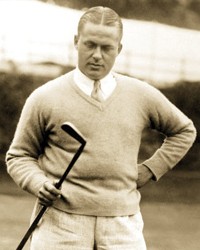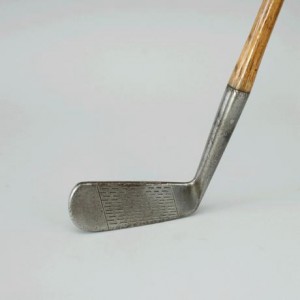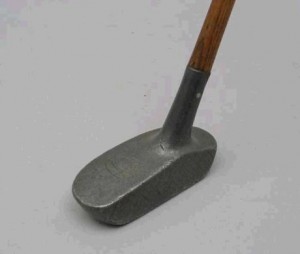PLAYING GUIDE
Today’s modern club shafts are manufactured to very exact specifications and have well controlled flex and torque characteristics that are consistent between individual shafts with the same specifications. Hickory shafts being made from natural timber will flex and twist much more than a modern club and display a much greater range of variability in performance.
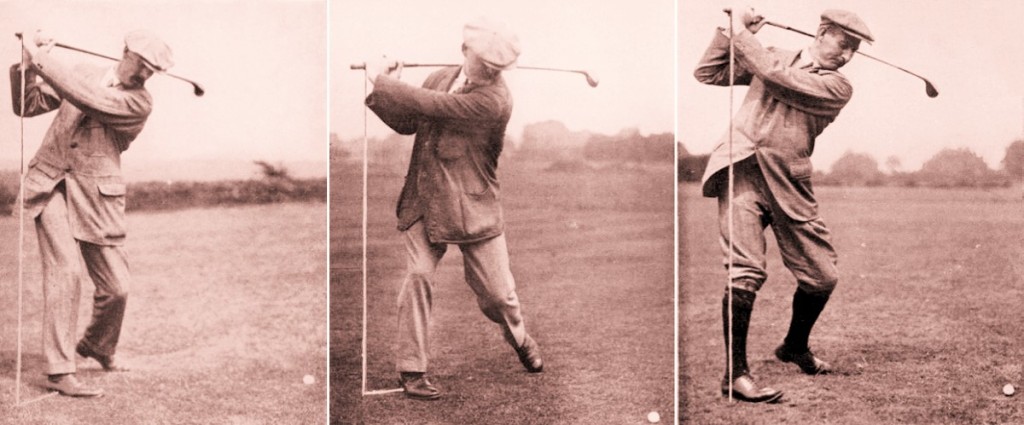
Braid, Taylor and Vardon
That is not to say hickory clubs are vastly inferior, Bobby Jones’ played his entire competitive career with hickory shafted clubs and with his combination of rhythm and balance produced a swing that could generate a driver speed of over 110mph and hit drives well over 250 yards!
When his original clubs were stolen and then returned in 1929 he commissioned J Victor East to replicate the entire set. For Jones' replica driver East inspected 5000 pieces of first-grade hickory to find 4 suitable shafts. After further testing 2 shafts met the requirements and were made into finished clubs. Final testing showed one club to be an exact duplicate of Jones’ original driver.
There were no measurements of shaft flex, kick point, torque or swingweight during the hickory era. Two identical looking clubs can have vastly different playing characteristics. Clubs were chosen by feel and playability.
Generally speaking most period hickory clubs will rate somewhere between senior and regular flex. Clubs re-shafted with new hickory shafts offer the ability to select a stiffer flex than most traditional period shafted clubs. The biggest issue when playing with hickory clubs is learning how to control the torque or twisting of the club. The "torque" of a golf shaft is a measurement that refers to the amount that a shaft will resist twisting in response to a force. In a golf club that force is generated by the downswing force of the swing and the inherent design of golf clubs (where the shaft attaches to the heel end of the clubhead). Modern shafts with torque measurements of between 2 and 5 degrees hardly compare to the 20+ degrees of torque a typical period hickory shaft will have.
To maximize the natural “whip” of the hickory shaft and to minimize the twisting of the head at impact a smooth swing will frequently deliver the desired outcome. Resisting the urge to swing aggressively with maximum speed is the key to playing well with hickory clubs.
The Woods
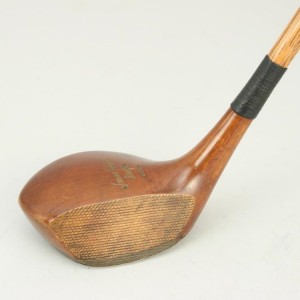 The two most common woods used in Hickory Golf are the Driver and the Brassie (so called because of the brass sole plate designed to protect the club against damage from hitting the ground during play). Generally both clubs are of similar length usually between 41”- 43” with driver lofts around 8-10 degrees and Brassies 12-16 degrees. The Brassie is the equivalent of the modern 3 wood.
The two most common woods used in Hickory Golf are the Driver and the Brassie (so called because of the brass sole plate designed to protect the club against damage from hitting the ground during play). Generally both clubs are of similar length usually between 41”- 43” with driver lofts around 8-10 degrees and Brassies 12-16 degrees. The Brassie is the equivalent of the modern 3 wood.
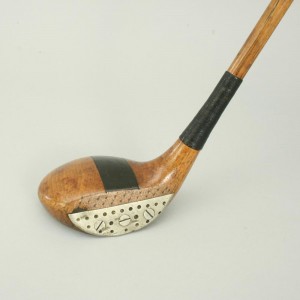 The shallow face of the clubs requires a much lower tee height compared to a modern driver, play them as you would a modern 3 or 4 wood from the tee. Before tees became widespread in the late 1920’s golfers used a tee made from moulded sand. One of the benefits of playing with such shallow-faced, small-headed clubs is their usability from the fairway.Without the benefits of modern technology the wooden heads hit the ball much lower than today’s clubs so allow for more run when playing with hickories.
The shallow face of the clubs requires a much lower tee height compared to a modern driver, play them as you would a modern 3 or 4 wood from the tee. Before tees became widespread in the late 1920’s golfers used a tee made from moulded sand. One of the benefits of playing with such shallow-faced, small-headed clubs is their usability from the fairway.Without the benefits of modern technology the wooden heads hit the ball much lower than today’s clubs so allow for more run when playing with hickories.
The Irons
A basic hickory set generally consists of 4 irons.
HICKORY IRONS MODERN EQUIVALENT
Mid iron 4-5 iron
Mashie 6-7 iron
Mashie Niblick 8-9 iron
Niblick Gap Wedge-Wedge
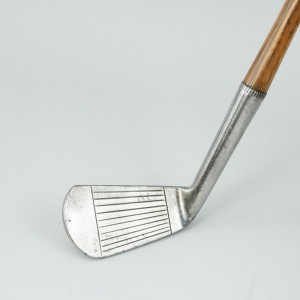 There were no true cavity back irons in the hickory period, all of the irons were variations of what we know as “blades”. The soles of hickory era irons are generally much thinner than modern irons and most have little or no bounce and thin leading edges which tend to make them more difficult to control when hitting from thin lies, particularly with the higher lofted clubs.
There were no true cavity back irons in the hickory period, all of the irons were variations of what we know as “blades”. The soles of hickory era irons are generally much thinner than modern irons and most have little or no bounce and thin leading edges which tend to make them more difficult to control when hitting from thin lies, particularly with the higher lofted clubs.
Hickory irons are not designed to take large divots and will dig sharply into the ground rather than slide through the turf. Aim to take a shallow divot or pick the ball cleanly from the turf.
Well maintained hickory shafts will withstand the rigours of constant impact with the ground for many years. There are situations on the course that should be avoided to prevent breakage or damage to the shafts. The most frequent cause of shaft breakage is from hitting a hidden tree root and most Hickory playing organizations will allow players to drop away from areas where tree roots are a concern.
Caution should also be used when playing from long grass/deep rough. In most cases the aim should be to get the ball back into play rather than attempting a full swing.
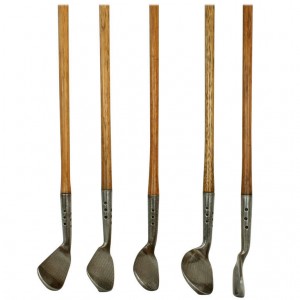 With shallow grooved or dot-punched club faces on most hickory irons the spin that can be generated is greatly reduced so expect much more run on approach shots. Allow for much lower levels of backspin on wedge and chip shots. Players from the hickory era relied on height to stop the ball and generally played a greater variety of shots to achieve the desired result. The bump and run shot is common place in the hickory game.
With shallow grooved or dot-punched club faces on most hickory irons the spin that can be generated is greatly reduced so expect much more run on approach shots. Allow for much lower levels of backspin on wedge and chip shots. Players from the hickory era relied on height to stop the ball and generally played a greater variety of shots to achieve the desired result. The bump and run shot is common place in the hickory game.
Putters
Putters post 1900, like the irons, were mostly made from mild steel although "gunmetal" (brass) and aluminium were also used. The heel shafted blade putter was the most prevalent style used during the hickory period.
Putters from this time were often a little more lofted and sometimes lighter than their modern day equivalents. With a light grip they feel sensational when stuck in the sweetspot.
